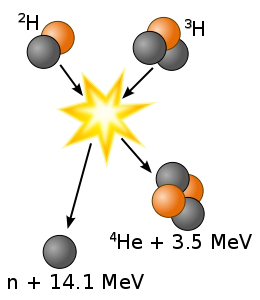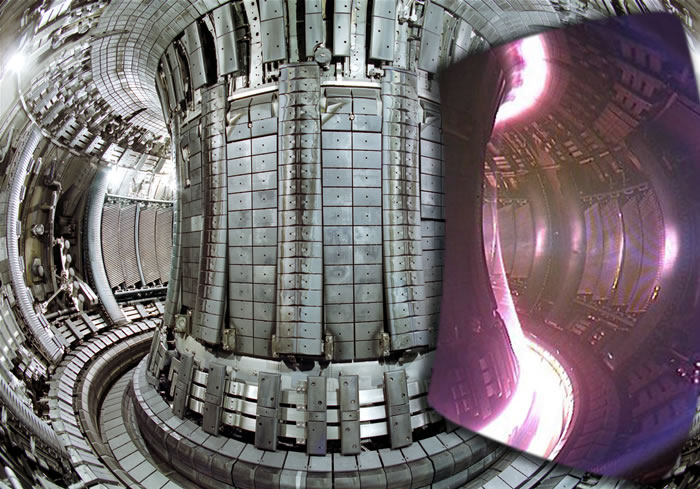The ITER project, using nuclear fusion to create energy
Interview with
Chris - The world is united behind a project called ITER, the International Thermonuclear Experimental Reactor. Later this decade, it will attempt to recreate on earth the physics that powers the sun. The aim is to harness fusion power to produce electricity. Brad Nelson is the chief engineer for the US arm of the project.
Brad - The nuclear power stations we have now are based on the fission process. Heavy nuclei are split to release energy - the famous e=mc2 equation. Whereas fusion occurs on the sun where lighter elements are fused to form heavier elements and to give off power.
Chris - I suppose one of the problems though is that the sun is a million earths - the temperature at the centre is really quite high, the pressure is huge, and we're trying to do what the sun does on the scale of a star on the surface of the earth.
Brad - That's correct. What the Sun uses is gravitational attraction to confine the fuel to create the very high densities you just mentioned. But in reality the temperatures in  the ITER reaction will be higher than they are in the sun - about 200 million degrees.
the ITER reaction will be higher than they are in the sun - about 200 million degrees.
Chris - This is to make the particles move a lot faster so that they hit each other harder and can get closer together. So you'll get those nuclei to fuse together which the sun does, as you say, by squeezing things very hard with gravity. We've got to do it another way.
Brad - That's correct. We use a plasma, which is a conducting, high temperature gas that we then confine with magnetic fields, certainly at 200 million degrees there is no material that will withstand that temperature so we must be very careful to keep the plasma away from any kind of wall.
Chris - So talk us through the process. What chemically will go into the reactor? What will be the process that happens? What will come out, apart from heat and energy?
Brad - The fuels that we will use in the ITER reactor are deuterium and tritium, they're heavy isotopes of hydrogen. Deuterium is found in sea water. We've heard of heavy water, well deuterium is the hydrogen isotope in heavy water. Tritium is a more unstable isotope which has to be created. In this case, if you bombard lithium with neutrons you can create tritium. And so in future reactors where we want to be self-sufficient in fuel we would have a tritium breeding blanket around the outside of the plasma where neutrons would interact to create tritium and the process would be self-sustaining.
Chris - And the tritium and the deuterium are fused together to make what?
Brad - In the reactor the tritium and deuterium are fused together making an alpha particle, or a helium nucleus, which has a fair amount of energy, and then a high energy neutron - 14 MeV neutron. So it's a very energetic neutron, and has some issues with the damaging materials. So materials issues are a big problem, and what ITER's trying to discover is whether the alpha particle, or helium nucleus, which is charged, will remain in the plasma long enough to give off its energy and heat the new fuel coming in and keep the reaction sustained.
Chris - Can you then talk us through exactly how it will work? So, if I were to set foot in the core of what will be the core of the ITER reactor in the future, what will I see?
 Brad - The ITER is what's called a tokamak, which is a toroidal magnetic device. So imagine a doughnut which you surround with very strong electromagnets, creating a very high electromagnetic field. You first create a plasma by heating up some very rarefied gas inside the doughnut, ionising it, and then you gradually induce a very high current in the gas. In this case, 15 million amps. So we have a plasma, with 15 million amps, inside a very strong magnetic field, and this provides a magnetic bottle if you will that contains the plasma, keeps it in the core of the reactor and away from the walls. We then continue to heat the plasma until it reaches the thermonuclear conditions which allow the fuel to fuse. The neutrons come out, the neutrons hit the wall, and we absorb the power in the walls, carry the heat away - in water in the case of ITER, but in future reactors it would probably be helium. And that power would be used to run turbines and generate electricity.
Brad - The ITER is what's called a tokamak, which is a toroidal magnetic device. So imagine a doughnut which you surround with very strong electromagnets, creating a very high electromagnetic field. You first create a plasma by heating up some very rarefied gas inside the doughnut, ionising it, and then you gradually induce a very high current in the gas. In this case, 15 million amps. So we have a plasma, with 15 million amps, inside a very strong magnetic field, and this provides a magnetic bottle if you will that contains the plasma, keeps it in the core of the reactor and away from the walls. We then continue to heat the plasma until it reaches the thermonuclear conditions which allow the fuel to fuse. The neutrons come out, the neutrons hit the wall, and we absorb the power in the walls, carry the heat away - in water in the case of ITER, but in future reactors it would probably be helium. And that power would be used to run turbines and generate electricity.
Chris - It's being built in France, isn't it? But it's an international project?
Brad - Yes, it's an international project. Roughly half the world's populations are living in countries where the government is subscribed to build ITER. So the European Union is involved, Japan is involved, the Russian federation, the US, Korea, China, and India are all involved in this effort.
Chris - And dare I ask the price tag?
Brad - It's hard to say exactly because the countries are providing the equipment for the project as an in-kind contribution. So, rather than all send money and have the project buy the equipment, the parties to the agreement are actually sending the equipment itself. So the exact cost is hard to say, but in round numbers it's something around 20 billion dollars.
Chris - Two or three LHCs?
Brad - I suppose that would be right, yes.
Chris - So, not cheap. But if it does deliver then the future energy savings will be huge. That was Brad Nelson, ITER's chief engineer.










Comments
Add a comment